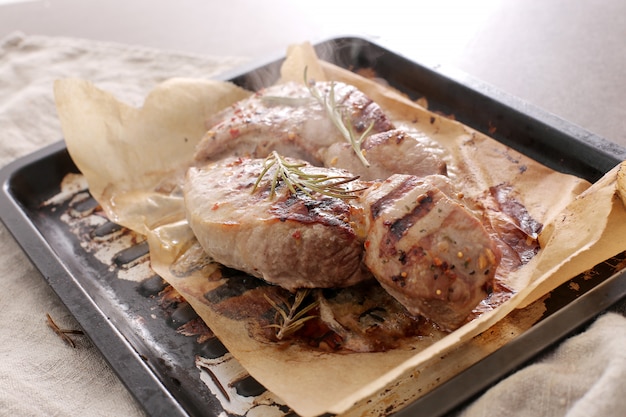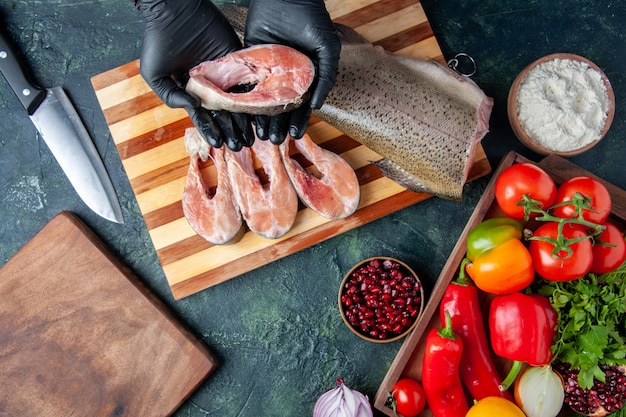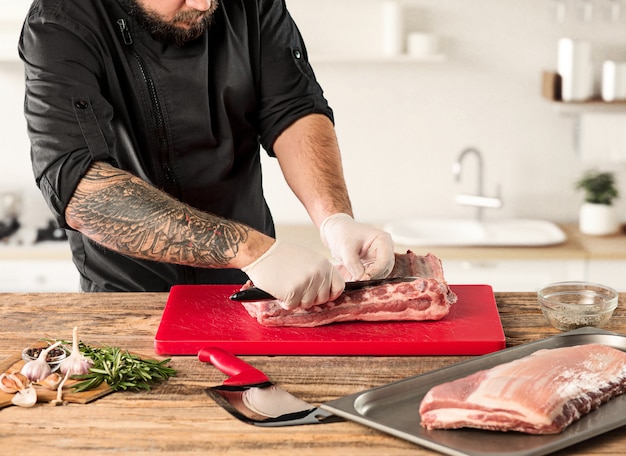Let's talk about Pernil, shall we? You know, that melt-in-your-mouth, slow-cooked, crispy-skinned Puerto Rican pork shoulder that always steals the show? My love affair with Pernil started at a friend's family gathering. The aroma alone was enough to make me weak at the knees, and the first bite? Pure bliss. The pork was so incredibly juicy and flavorful, with a tender texture that just melted in my mouth. And that crackling skin? Don't even get me started. It was the perfect combination of crispy and savory. I knew right then and there that I had to learn how to make this masterpiece myself.
The journey to Pernil perfection has been a wonderful adventure, and today, I'm sharing all my tips and tricks with you. Get ready to unlock the secrets to creating the most delicious Pernil that will have your guests begging for seconds, and possibly even licking their plates clean. It's a bit of a labour of love, but trust me, every minute is worth it. We'll cover everything from choosing the perfect cut of meat to mastering the marinade and cooking techniques.
(Part 1) Choosing the Right Pork Shoulder: A Foundation for Flavour

First things first, you need to get your hands on a good quality pork shoulder. This is the foundation of your Pernil, so choose wisely. Look for a nice, thick piece with a good amount of marbling. This fat is crucial, as it melts down during cooking, basting the meat and creating that irresistible, juicy, and flavorful experience. It's usually labelled as "pork shoulder Boston butt," but if you're unsure, just ask your friendly butcher for guidance. They'll be happy to point you in the right direction.
Size Matters
Now, when it comes to size, it really depends on how many people you're feeding. For a small gathering, a 4-5lb pork shoulder should be enough. But if you're expecting a crowd, go for a bigger one – 6-8 lbs would be perfect. You can always freeze any leftovers for later, but trust me, you'll be hard-pressed to resist another serving.
Fat: The Unsung Hero
Remember, don't shy away from the fat! It's not just about flavor, it's about texture too. The fat renders down during cooking, creating a luscious layer of golden goodness that not only adds flavor but also helps to keep the meat moist and tender. And let's not forget that amazing crispy skin we were talking about - it's all thanks to the fat! So embrace the fat, my friend, it's your Pernil's secret weapon.
(Part 2) The Art of the Pernil Marinade: A Symphony of Flavors

Okay, now we're getting to the fun part - the marinade. This is where you really get to unleash your creativity and add your own personal touch. There's no one "right" way to make Pernil marinade, but there are some classic ingredients that you can't go wrong with. Think of it as a symphony of flavors, where each ingredient plays a vital role in creating the final masterpiece.
Essential Ingredients: The Cornerstones of Flavor
- Garlic: A must-have! It adds a pungent, savory flavour that's essential for Pernil. It's the backbone of the flavor profile, giving it depth and richness. I usually use about 4-5 cloves, minced or crushed for maximum flavor impact.
- Adobo: This is where things start to get really exciting! Adobo is a blend of spices used in many Latin American cuisines. It's the secret ingredient that adds that unique, complex flavor to Pernil. You can buy pre-made adobo seasoning, but I prefer to make my own. It's super easy and allows me to adjust the flavour to my liking. I usually use a combination of oregano, cumin, paprika, black pepper, and a pinch of salt. You can also add other spices like bay leaves, cilantro, or even a touch of cayenne pepper for some heat.
- Citrus: The acidity of citrus helps to break down the proteins in the meat, making it more tender and enhancing the flavor. I use a mix of orange and lime juice - it gives the Pernil a bright and refreshing flavour that cuts through the richness of the pork. You can also add some grapefruit or even pineapple juice if you want a sweeter taste.
- Olive Oil: This helps to keep the meat moist and adds a rich flavor, acting as a lubricant that helps the other ingredients to penetrate the meat.
- Salt: Don't forget the salt! It's crucial for enhancing the flavour of the meat, drawing out its natural juices and bringing everything together.
Make it Your Own: A Personal Touch
Once you've got the basics down, feel free to experiment with other flavours. I've added things like chopped onions, cilantro, and even a little bit of honey to my marinade. It's all about finding what you like best. You can create your own signature marinade, adding your own personal touch to this already delicious dish.
(Part 3) Preparing the Pork Shoulder for Perfection: Setting the Stage for Success

Now, it's time to prep your pork shoulder. This is the crucial step that ensures you end up with juicy, flavorful meat and that coveted crispy skin. Think of it as setting the stage for a culinary masterpiece.
Getting the Skin Ready: Scoring for Success
Start by scoring the skin of the pork shoulder. This involves making small cuts, about 1/2 inch apart, across the surface of the skin. This helps the skin to crisp up nicely during cooking, allowing the fat to render and create that irresistible crackling texture. Be careful not to cut too deep into the meat, just focus on scoring the skin.
Rub it In: A Flavorful Embrace
Next, rub the marinade all over the pork shoulder, making sure to get it into all the nooks and crannies. You want to create a flavorful embrace, ensuring that every part of the meat is coated. It's best to do this the day before cooking, and let it sit in the fridge overnight. This allows the flavors to really penetrate the meat, transforming it into a symphony of tastes.
The Importance of Salt: A Symphony of Flavor
Don't forget to season generously with salt. It's crucial for bringing out the flavour of the pork and helping to create that crispy skin. I usually sprinkle a generous amount of salt on the skin and then rub it in with my hands, ensuring that it's evenly distributed. This creates a salty crust that helps to lock in the moisture and enhance the flavor of the meat.
(Part 4) The Slow and Steady Approach to Cooking: Patience is Key
Now for the fun part - cooking the Pernil. There are a couple of ways to go about this. You can either roast it in the oven or cook it in a slow cooker. Both methods have their advantages, but I prefer the oven method because it gives me more control over the cooking process and allows for that amazing crispy skin. However, if you're looking for a more hands-off approach, the slow cooker is a great option.
Oven-Roasted Glory: A Symphony of Heat
Preheat your oven to 325 degrees Fahrenheit (160 degrees Celsius). Place the pork shoulder in a roasting pan and pour about 1 cup of the marinade over it. Add some sliced onions and a few sprigs of fresh rosemary to the pan - this will add even more depth and complexity to the flavor.
Cover the roasting pan tightly with aluminum foil and cook the pork shoulder for about 2-3 hours. This allows the meat to tenderize and absorb all the delicious flavors of the marinade. After 2-3 hours, remove the foil and increase the oven temperature to 400 degrees Fahrenheit (200 degrees Celsius). Continue cooking for another 1-2 hours, or until the internal temperature of the meat reaches 190 degrees Fahrenheit (88 degrees Celsius). This final stage allows the skin to crisp up and the fat to render, creating that irresistible golden-brown crust.
Slow Cooker Magic: Hands-Off Perfection
If you prefer a more hands-off approach, you can also cook the Pernil in a slow cooker. Place the pork shoulder in the slow cooker, add the marinade, and cook on low for 8-10 hours. This method will give you incredibly tender and flavorful meat, but you won't get that crispy skin. It's a great option for busy days or if you're not concerned about achieving the perfect crispy skin.
(Part 5) Mastering the Art of Crispy Skin: A Culinary Triumph
Alright, here's the secret to achieving that incredible crispy skin on your Pernil. It's all about getting the fat just right. This is the final act in the culinary drama, the moment where you transform your Pernil from good to absolutely spectacular.
The Role of Fat: The Key to Crispy Perfection
As the pork shoulder cooks, the fat renders down and creates a layer of delicious, golden-brown fat on the skin. This is what makes the skin crispy and irresistible. It's a beautiful transformation, where the fat slowly melts away, leaving behind a crispy, flavorful crust.
The Final Touch: Basting for Glory
About 30 minutes before the Pernil is done, baste the skin with some of the rendered fat. This helps to further crisp up the skin and gives it that beautiful, glistening finish. Think of it as giving the skin a final kiss of flavor and texture, ensuring that it reaches its full potential.
The Power of Heat: A Final Burst of Flavor
If you want an even crispier skin, you can transfer the Pernil to the broiler for a few minutes. Just keep a close eye on it, as it can burn easily. This is the final act, a quick burst of heat that brings the crispy skin to life.
(Part 6) The Perfect Accompaniments: A Symphony of Flavors
No Pernil is complete without some delicious accompaniments. These are the supporting actors in the culinary drama, adding depth and complexity to the overall experience. Here are a few of my favourites:
- Mofongo: This is a classic Puerto Rican dish made with mashed plantains, garlic, and olive oil. It's a perfect way to soak up all the juices from the Pernil, creating a harmonious blend of textures and flavors.
- Rice and Beans: A simple but delicious combination that goes perfectly with Pernil. This provides a balanced foundation, complementing the richness of the pork.
- Avocado Salad: A refreshing and healthy side dish that contrasts beautifully with the rich flavours of the Pernil. The creamy avocado provides a cool contrast to the warm, savory flavors of the pork.
- Sweet Plantain: These are a sweet and sticky treat that's a perfect way to end your Pernil feast. The sweetness of the plantains provides a delightful contrast to the savory flavors of the Pernil, leaving a lasting impression.
(Part 7) The Joy of Leftovers: A Second Act of Deliciousness
Let's be honest, you're probably going to have some leftovers. And that's a good thing! Pernil is even better the next day, and there are endless possibilities for using it. Think of it as a second act, where the flavors deepen and the textures become even more enjoyable.
Sandwich Sensations: A Taste of Paradise
Make delicious sandwiches with leftover Pernil. You can serve it on bread, rolls, or even tortillas. Add your favourite toppings, like lettuce, tomato, onion, and cheese. It's a delicious and satisfying way to enjoy the leftover Pernil.
Soup Superstar: A Warm and Flavorful Embrace
Shred the leftover Pernil and add it to a hearty soup. It's a great way to use up leftover meat and add a burst of flavour to your soup. The shredded pork adds a rich, savory depth to the soup, making it even more satisfying.
Pizza Power: A Culinary Fusion
Chop up the leftover Pernil and use it as a topping for your pizza. It's a delicious and unconventional way to use up leftovers. The combination of crispy pork and melted cheese is truly irresistible.
(Part 8) FAQs: Your Pernil Questions Answered
What kind of pork shoulder should I use?
You want to use a pork shoulder Boston butt, as it’s a thicker cut with more marbling. This cut is ideal for Pernil because it provides a good amount of fat and a tender texture that melts in your mouth.
How long does it take to cook Pernil?
It takes about 4-5 hours to cook Pernil in the oven. You'll need to factor in time for the initial slow cooking and the final crisping up of the skin.
How do I know if my Pernil is done?
The Pernil is done when the internal temperature reaches 190 degrees Fahrenheit (88 degrees Celsius). You can use a meat thermometer to check the internal temperature.
What are some good side dishes for Pernil?
Mofongo, rice and beans, avocado salad, and sweet plantains are all excellent choices. These side dishes provide a balanced and flavorful accompaniment to the Pernil, creating a complete culinary experience.
What can I do with leftover Pernil?
You can make sandwiches, add it to soup, or use it as a pizza topping. Leftover Pernil is incredibly versatile and can be incorporated into a variety of dishes, ensuring that nothing goes to waste.
Everyone is watching

How to Cook Frozen Lobster Tails Perfectly: A Step-by-Step Guide
RecipesLobster. Just the word conjures up images of lavish meals, special occasions, and a taste of luxury. But let's...

Pigs in a Blanket Cooking Time: How Long to Bake for Perfect Results
RecipesAh, pigs in a blanket. Just the name conjures up images of those delightful little parcels of crispy pastry en...

Pork Fillet Cooking Time: How Long to Cook It Perfectly
RecipesPork fillet, or tenderloin as it's sometimes called, is a real favourite in our house. It's so versatile, and...

The Ultimate Guide to Cooking Delicious Frankfurters
RecipesLet's face it, we all love a good frankfurter. It's a classic, simple, and always satisfying. But let's be rea...

The Ultimate Guide to Tender, Juicy Pulled Pork
RecipesRight, let's talk pulled pork. It's one of those dishes that just screams "comfort food," doesn't it? I mean...
